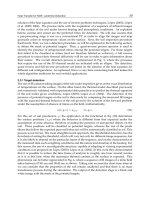Developments in Heat Transfer Part 1 docx
Bạn đang xem bản rút gọn của tài liệu. Xem và tải ngay bản đầy đủ của tài liệu tại đây (2.16 MB, 40 trang )
DEVELOPMENTS IN
HEAT TRANSFER
Edited by
Marco Aurélio dos Santos Bernardes
Developments in Heat Transfer
Edited by Marco Aurélio dos Santos Bernardes
Published by InTech
Janeza Trdine 9, 51000 Rijeka, Croatia
Copyright © 2011 InTech
All chapters are Open Access articles distributed under the Creative Commons
Non Commercial Share Alike Attribution 3.0 license, which permits to copy,
distribute, transmit, and adapt the work in any medium, so long as the original
work is properly cited. After this work has been published by InTech, authors
have the right to republish it, in whole or part, in any publication of which they
are the author, and to make other personal use of the work. Any republication,
referencing or personal use of the work must explicitly identify the original source.
Statements and opinions expressed in the chapters are these of the individual contributors
and not necessarily those of the editors or publisher. No responsibility is accepted
for the accuracy of information contained in the published articles. The publisher
assumes no responsibility for any damage or injury to persons or property arising out
of the use of any materials, instructions, methods or ideas contained in the book.
Publishing Process Manager Ivana Lorković
Technical Editor Teodora Smiljanic
Cover Designer Jan Hyrat
Image Copyright slava_vn, 2010. Used under license from Shutterstock.com
First published August, 2011
Printed in Croatia
A free online edition of this book is available at www.intechopen.com
Additional hard copies can be obtained from
Developments in Heat Transfer, Edited by Marco Aurélio dos Santos Bernardes
p. cm.
ISBN 978-953-307-569-3
Contents
Preface XI
Chapter 1 Thermal Effects in Optical Fibres 1
Paulo André, Ana Rocha, Fátima Domingues and Margarida Facão
Chapter 2 Heat Transfer for NDE: Landmine Detection 21
Fernando Pardo, Paula López and Diego Cabello
Chapter 3 The Heat Transfer Enhancement
Analysis and Experimental Investigation of
Non-Uniform Cross-Section Channel SEMOS Heat Pipe 47
Shang Fu-Min, Liu Jian-Hong and Liu Deng-Ying
Chapter 4 Magneto Hydro-Dynamics and
Heat Transfer in Liquid Metal Flows 55
J. S. Rao and Hari Sankar
Chapter 5 Thermal Anomaly and Strength of Atotsugawa Fault, Central
Japan, Inferred from Fission-Track Thermochronology 81
Ryuji Yamada and Kazuo Mizoguchi
Chapter 6 Heat Transfer in Freeze-Drying Apparatus 91
Roberto Pisano, Davide Fissore and Antonello A. Barresi
Chapter 7 Radiant Floor Heating System 115
Byung-Cheon Ahn
Chapter 8 Variable Property Effects in
Momentum and Heat Transfer 135
Yan Jin and Heinz Herwig
Chapter 9 Bioheat Transfer 153
Alireza Zolfaghari and Mehdi Maerefat
Chapter 10 The Manufacture of Microencapsulated Thermal
Energy Storage Compounds Suitable for Smart Textile 171
Salaün Fabien
VI Contents
Chapter 11 Heat Transfer and Thermal Air Management
in the Electronics and Process Industries 199
Harvey M. Thompson
Chapter 12 Unsteady Mixed Convection Flow in the Stagnation
Region of a Heated Vertical Plate Embedded in a Variable
Porosity Medium with Thermal Dispersion Effects 217
S. M. Alharbi and I. A. Hassanien
Chapter 13 Heat Generation and Transfer on Biological
Tissues Due to High-Intensity Laser Irradiation 227
Denise M. Zezell, Patricia A. Ana,
Thiago M. Pereira, Paulo R. Correa and Walter Velloso Jr.
Chapter 14 Entransy Dissipation Theory
and Its Application in Heat Transfer 247
Mingtian Xu
Chapter 15 Inverse Space Marching Method for
Determining Temperature and Stress
Distributions in Pressure Components 273
Jan Taler, Bohdan Weglowski,
Tomasz Sobota, Magdalena Jaremkiewicz and Dawid Taler
Chapter 16 Experimental Prediction of
Heat Transfer Correlations in Heat Exchangers 293
Tomasz Sobota
Chapter 17 High Temperature Thermal Devices for
Nuclear Process Heat Transfer Applications 309
Piyush Sabharwall and Eung Soo Kim
Chapter 18 Flow Properties and Heat Transfer of
Drag-Reducing Surfactant Solutions 331
Takashi Saeki
Chapter 19 Entransy - a Novel Theory in
Heat Transfer Analysis and Optimization 349
Qun Chen, Xin-Gang Liang and Zeng-Yuan Guo
Chapter 20 Transient Heat Transfer and Energy
Transport in Packed Bed Thermal Storage Systems 373
Pei Wen Li, Jon Van Lew, Wafaa Karaki,
Cho Lik Chan, Jake Stephens and James. E. O’Brien
Chapter 21 Role of Heat Transfer on Process
Characteristics During Electrical Discharge Machining 417
Ahsan Ali Khan
Contents VII
Chapter 22 Thermal Treatment of Granulated
Particles by Induction Thermal Plasma 437
M. Mofazzal Hossain, Takayuki Watanabe
Chapter 23 Method for Measurement of Single-Injector
Heat Transfer Characteristics and Its Application
in Studying Gas-Gas Injector Combustion Chamber 455
Guo-biao Cai, Xiao-wei Wang and Tao Chen
Chapter 24 Heat Transfer Related to
Gas Hydrate Formation/Dissociation 477
Bei Liu, Weixin Pang, Baozi Peng, Changyu Sun and Guangjin Chen
Chapter 25 Progress Works of High and
Super High Temperature Heat Pipes 503
Wei Qu
Chapter 26 Design of the Heat Conduction Structure
Based on the Topology Optimization 523
Yongcun Zhang, Shutian Liu and Heting Qiao
Chapter 27 Thermal Modelling for
Laser Treatment of Port Wine Stains 537
Dong Li, Ya-Ling He and Guo-Xiang Wang
Chapter 28 Study of the Heat Transfer Effect
in Moxibustion Practice 557
Chinlong Huang and Tony W. H. Sheu
Chapter 29 Heat and Mass Transfer in Jet Type Mold Cooling Pipe 573
Hideo Kawahara
Chapter 30 Thermal State and
Human Comfort in Underground Mining 589
Vidal F. Navarro Torres and Raghu N. Singh
Chapter 31 Heat Transfer in the Environment: Development and
Use of Fiber-Optic Distributed Temperature Sensing 611
Francisco Suárez, Mark B. Hausner,
Jeff Dozier, John S. Selker and Scott W. Tyler
Chapter 32 Prandtl Number Effect on
Heat Transfer Degradation in MHD Turbulent
Shear Flows by Means of High-Resolution DNS 637
Yoshinobu Yamamoto and Tomoaki Kunugi
Chapter 33 Effective Method of
Microcapsules Production for Smart Fabrics 649
Luz Sánchez-Silva, Paula Sánchez and Juan F. Rodríguez
VIII Contents
Chapter 34 Heat Conduction in Nonlinear Media 667
Michael M. Tilleman
Preface
Recent 40 years have witnessed considerable advances in experimental, theoretical and
calculation approaches as well as in industrial utilizations. In this way, this book aims
to bring together current progresses in some special heat transfer fields contributing to
the dissemination of high-quality research efforts. Therefore, issues comprising heat
transfer fundamental concepts and modes (specifically conduction, convection and
radiation), bioheat, entransy theory development, micro heat transfer, high
temperature applications, turbulent shear flows, mass transfer, heat pipes, design
optimization, medical therapies, fiber-optics, heat transfer of in surfactant solutions,
landmine detection, heat exchangers, radiant floor, packed bed thermal storage
systems, inverse space marching method, heat transfer in short slot ducts, freezing an
drying mechanisms, variable property effects in heat transfer, heat transfer in
electronics and process industries, fission-track thermochronology, combustion, heat
transfer in liquid metal flows, human comfort in underground mining, heat transfer
on electrical discharge machining, mixing convection are included in this book aiming.
The experimental and theoretical investigations, assessment and enhancement
techniques illustrated here aspire to be useful for many researchers, scientists,
engineers and graduate students.
Marco Aurélio dos Santos Bernardes
CRP Henri Tudor, CRTE
Esch-sur-Alzette
Luxembourg
1
Thermal Effects in Optical Fibres
Paulo André, Ana Rocha, Fátima Domingues and Margarida Facão
Instituto de Telecomunicações and Departamento de Física, Universidade de Aveiro
Portugal
1. Introduction
Optical fibres are essential components in the modern telecommunication scenario. From
the first works dealing with the optimization of optical fibres transmission characteristics to
accommodate long distance data transmission, realized by Charles Kao (Nobel Prize of
Physics in 2009), until the actual optical fibre communication networks, a long way was
paved.
The developments introduced in the optical communication systems have been focused in 3
main objectives: increase of the propagation distance, increase of the transmission capacity
(bitrate) and reduction of the deployment and operation costs. The achievement of these
objectives was only possible due to several technological breakthroughs, such as the
development of optical amplifiers and the introduction of wavelength multiplexing
techniques. However, the consequence of those developments was the increase of the total
optical power propagating along the fibres.
Moreover, in the last years, the evolution of the optical networks has been toward the
objective of deploying the fibre link end directly to the subscribers home (FTTH – fibre to
the home).
Thus, the conjugation of high power propagation and tight bending, resulting from the
actual FTTH infrastructures, is responsible for fibre lifetime reduction, mainly caused by the
local increase of the coating temperature. This effect can lead to the rupture of the fibre or to
the fibre fuse effect ignition with the consequent destruction of the optical fibre along
kilometres.
In this work, we analyze the thermal effects occurring in optical fibres, such as the coating
heating due to high power propagation in bent fibres and the fibre fuse effect. We describe
the actual state of the art of these phenomena and our contribution to the subject, which
consists on both experimental and numerical simulation results.
2. Literature review
The fibre fuse effect, named due to the similarity with a burning fuse, was first observed in
1987 (Kashyap, 1987; Kashyap et al., 1988). At that time, the effect was observed on a single
mode silica fibre illuminated by an optical signal with an average power density higher than
5MW/cm
2
. Like a burning fuse, after the optical fibre fuse ignition, the fuse zone propagates
towards the light source while a visible white light is emitted. After the fuse zone
propagation, the fibre core shows a string of voids, being permanently damaged. The
phenomenon was always associated with a thermal effect and although there are not yet
Developments in Heat Transfer
2
very accurate experimental data for the actual temperature achieved in the fibre core, it is
believe that the peak temperature is up above the silica vaporization point, around 3300 K.
Some authors also refer that the white light emission characteristic of this effect may indicate
temperatures that would allow plasma like fuse zone (10
4
) (Hand et al., 1988
b;
Dianov et al.,
2006; Shuto, 2010).
The first explanation for the effect related it to a thermal self-focusing mechanism (Kashyap
et al., 1988). Afterwards, the fuse zone was identified as a soliton-like thermal shock-wave
which would occur by strong thermal dependent absorption due to the creation of
Ge-related defects in Ge doped core fibre. To sustain this hypothesis, the a Ge doped fibre
was heated up to 1000ºC in the absence of any propagating optical signal and the same kind
of periodic damaged pattern was produced (Driscoll et al., 1991), however this result has not
been reproduced by any others research groups.
At the time of these first observations the fuse effect did not represent a practical problem,
since the total power injected in the network optical fibres was well below the power
densities used in the experiments. However, the rise of optical communications demand and
the consequent increase of the injected power have promoted the fuse effect to one of the
fundamental issues which should be considered while developing and maintaining optical
networks. Hence, for several years the phenomenon was referred as the origin of the optical
fibres damage, but only in the presence of high powers. It was only a few years ago that the
scientific community turned to this effect in order to explain it better but also to design
devices able to detect and halt this catastrophic effect.
Nowadays, the most accepted explanation for the fuse effect describes it as an absorption
enhanced temperature rise that propagates toward the light source by thermal conduction
and driven by the optical power itself. The first numerical simulation of the fuse
propagation used an explicit finite-difference method where it was assumed that the
electrical conductivity and consequently the absorption of the core increase rapidly above a
given temperature, Tc. Using this thermally induced optical absorption, Tc of 1100 ºC and an
optical power of 1 W, the core temperature was shown to reach 100000 ºC (Shuto et al.,
2003), which is well above the temperature of the fuse zone measured by (Dianov et al.,
2006).
Also, the trigger to ignite this effect was studied. The trigger is a high loss local point in the
fibre network, usually in damaged or dirty connectors or in tight fibre bends that, combined
with high power signals, generate a heating point (Andre et al., 2010
b
; Seo et al., 2003;
Martins et al., 2009; Andre et al., 2010
a
). The specific mechanism associated with the fuse
effect generation in optical connectors was also studied and correlated with the absorption
of the dust particles in the connector end face (Shuto et al., 2004
c
).
Another important issue is the power density threshold to initiate and maintain the fibre
fuse propagation. The investigation so far indicates that the power density threshold is ~1-5
MW/cm
2
, depending on the type of fibre and on the signal wavelength (Davis et al., 1997;
Seo et al., 2003). Note that the first experiments using microstructured fibres have shown
that the optical power density threshold value to ignite the phenomena is 10 times higher in
these fibres than in traditional step index silica fibres (Dianov et al., 2004
b
).
The increase of absorption that is believed to take place during fuse propagation was related
with Ge’ defects, as mentioned above, but also with Si E’ defects in the Germanium doped
silica core optical fibres. These defects are induced at high temperatures, like the
temperatures present in the fibre drawing process (Hanafusa et al., 1985). The E’ defects are
Thermal Effects in Optical Fibres
3
associated with oxygen vacancies ≡Ge−Si≡ and are stable at temperatures above 870 K. The
conjugation of this temperature dependent absorption mechanism with the absorption of
the SiO specimen, produced by the thermal decomposition reaction of the Silica glass at high
temperatures, occurring for temperatures above 3000 ºC, was considered by Shuto et al to
numerically simulate the fuse effect ignition and propagation. He reported estimate for the
Silica absorption coefficient was 10
7
m
-1
at 6000 K for a wavelength of 1064 nm (Shuto, 2010).
Dianov et al has experimentally demonstrated that the radiation spectrum for the optical
discharge, propagating through the silica fibre, is close to that of the blackbody with plasma
temperature values of 10
4
K. The observed optical discharge velocities were up to 10 m/s
on step index single mode fibre (Dianov et al., 2006) and 30 m/s for Erbium doped
fibre(Davis et al., 1997).
Atkins et al propose a model for the bubble and voids tracks based on the Rayleigh
instability due to the capillary effects in the molten silica that surrounds the vaporised fibre
core(Atkins et al., 2003). The void formation and other dynamics of the fibre fuse
propagation were exhaustively studied, leading to models for the voids and bubbles shape
(Todoroki, 2005
b;
Todoroki, 2005
c;
Yakovlenko, 2006
a
), and profile models for the optical
discharge (Todoroki, 2005
a
). Todoroki has also shown that is possible to have optical
discharge without the formation of voids, along short distances, being this responsible by
the irregular patterns on the voids trail (Todoroki, 2005
d
).
Other authors have also observed and studied the fibre fuse effect in special fibres like hole
assisted fibre (Hanzawa et al., 2010), high numerical aperture fibres (Wang et al., 2008),
polarization maintaining fibres(Lee et al., 2006) or in dispersion shift and non zero
dispersion shift fibres (Rocha et al., 2010; Andre et al., 2010
a
).
Recently, more accurate simulation models for fuse propagation have been proposed
(Yakovlenko, 2006
b
), or even alternative models based on ordinary differential equations
that represent time saving in the numerical integration (Facao et al., 2011).
The concern with the effects for the network structure caused by the triggering of the fuse
effect imposes the development of devices with the capacity to stop the fuse zone
propagation. An early solution proposed in 1989 was the use of single mode tapers (Hand et
al., 1989). The decrease of the fibre cladding led to expansion of the optical discharge plasma
and to decrease of the power density, this results in the termination of the fuse propagation
(Dianov et al., 2004
a
). Others proposed solutions to detect the fuse effect that are based in the
analysis of the electric spectrum of the back reflected optical signal (Abedin et al., 2009), or
in the fast temperature increase in the fibre outer surface (Rocha et al., 2011).
The deployment of FTTH networks imposes a new challenge, the dissemination of the
optical fibre infrastructure in the access networks, where the fibre installation conditions are
not always the more adequate. In these conditions, the deployed fibre is subject to tight
bending, which impose an additional attenuation for the network power budget. The
additional attenuation of waveguides subject to tight bending is a well know phenomenon,
studied in 1976 by Marcuse(Marcuse, 1976). Marcuse associated the additional losses in
bent waveguides with the optical signal radiated to the cladding region, this model was
later improved by other authors (Harris et al., 1986; Valiente et al., 1989; Schermer et al.,
2007).
Besides the new attenuation limits imposed by the bending, other constrain was observed.
For high propagation power signals, the optical modes irradiated to the cladding, are
absorbed in the primary coating, resulting in a temperature increase. This local heating
Developments in Heat Transfer
4
point can induce the fuse effect already referred above or can reduce the fibre lifetime
(Percival et al., 2000; Glaesemann et al., 2006; Sikora et al., 2007).
The first works on this subject have shown that the temperature achieved by the fibre
coating was linearly correlated to the propagated optical power (Logunov et al., 2003).
However, this linear model fails to describe the coating temperature for high power
propagation (> 1 W), and recently an improved model that considers a nonlinear absorption
coefficient for the coating was proposed (Andre et al., 2010
b
).
This topic has attracted the focus of the scientific community and many new achievements
have been reported in the last years technical conferences. Namely, the correlation of
temperature and fibre time failure (Davis et al., 2005), the definition of the safety bending
limits (Andre et al., 2009; Rocha et al., 2009
a
). Recently, this topic was also studied in the
new bend insensitive fibres (G.657), showing that the maximum power that can be injected
safely in these fibres without coating risk is > 3 W (Bigot-Astruc et al., 2008).
3. Fibre fuse effect
As described in the previous section, the fibre fuse effect is a phenomenon that can occur in
optical fibres in the presence of high optical powers and that may lead to the destruction of
the optical fibre, along several kilometres, and also reach the optical emitter equipment,
resulting in a permanent damage of the network active components.
However, the presence of high optical powers is not enough to ignite the fibre fuse but a
trigger consisting of a initial heating point is also required. During the fuse effect ignition,
this initial heating point causes a strong light absorption, due to the thermal induced
absorption increase, which in turn leads to a catastrophic temperature increase, up to values
that are high enough to vaporize the optical fibre core. This fuse zone propagates towards
the light source melting and vaporizing the fibre core while a visible white light is emitted,
as schematically illustrated in Fig 1. The propagation of the fuse zone only stops if the input
power is reduced below the threshold value or even shut down. After the fuse zone
propagation, the fibre core shows a string of voids, being permanently damaged.
Fig. 1. Schematic representation of the fuse effect ignition and propagation in an optical fibre
Thermal Effects in Optical Fibres
5
3.1 Experimental characterization of the fuse effect
As referred above, the fibre fuse effect is initiated in a local heating point, whenever the
optical signal have powers above a certain threshold value. Fig. 2 presents a controllable
experimental setup for the fibre fuse ignition.
High Power
Laser
Dummy fiber Test fiber
Fuse effect
ignition
Fig. 2. Experimental setup implemented to study the fibre fuse effect (Rocha et al., 2011)
This setup consists in a short length of fibre (~3m) connected to a high power laser. The
other end of the fibre is placed in contact with a metallic foil in order to produce a local
heating and promote the fuse effect ignition. In order to protect the optical source, an optical
isolator and a dummy fibre with 20 m are used between the test fibre and the laser.
Fig. 3 shows three frames from a movie, displaying the fuse propagation. In this movie, the
white light emitted (optical discharge) from the fuse zone is clearly seen. The fuse discharge
propagates at constant velocity towards the light source.
Fig. 3. Sequence of frames of the fibre fuse propagation in a SMF fibre, the time difference
between pictures is 0.1s
As mentioned above, if the optical power is reduced below a threshold value, the fuse
propagation stops and the optical discharge extinguishes. For standard single mode fibre
(SMF-28, manufactured by Corning) and a laser signal with a wavelength of 1480 nm, the
optical discharge extinguishes for an optical power of 1.39 W.
The fibre fuse propagation velocity increases with the optical power density, and could
reach values high as 10 m/s (Dianov et al., 2006; Rocha et al., 2011). Fig. 4 presents the
experimental velocities for the fuse effect propagation, ignited with a laser signal at 1480 nm
in a SMF-28 fibre. These experimental results indicate that, for this limited range of optical
power values, the fibre fuse propagation velocity is linearly dependent on the optical power
launched into the fibre, however, if we consider higher optical power values, the velocity
will be no longer a linear function function of the optical power (Dianov et al., 2006; Facao et
al., 2011).
Developments in Heat Transfer
6
1234
0.0
0.1
0.2
0.3
0.4
0.5
0.6
Optical power (W)
Optical discharge velocity (ms
-1
)
1.39
Fig. 4. Fuse discharge velocity as function of the injected optical power. The arrow
represents the power threshold and the line correspond to the data linear fit
(slope=0.110±0.002 m s
-1
W
-1
, intercept= 0.190±0.004 m s
-1
, correlation coefficient > 0.993)
20 30 40 50 60 70
0.0
2.5
5.0
7.5
10.0
12.5
Temperature increase (K)
Time (s)
Fig. 5. Fibre surface temperature increase as a function of time, recorded by the FBG sensor
during the optical discharge for an optical power of 3 W
Thermal Effects in Optical Fibres
7
The propagation velocity of the fuse zone was measured using a setup based on FBG (Fibre
Bragg Grating) temperature sensors that measure the fibre outer interface temperature
(Andre et al., 2010
a;
Rocha et al., 2011). Two fibres Bragg gratings were placed in contact
with the optical fibre outer interface, in two positions separated by 2 m.
The optical discharge leads to a temperature increase in the outer fibre surface, which is
monitored by the FBG sensors. The time difference between the temperature peaks,
recorded at each FBG, is then used to obtain the velocity of the optical discharge. Fig. 5
displays the temperature increase in the fibre surface measured by one FBG. This graph
presents an abrupt temperature increase, followed by an exponential decrease. The
temperature peak corresponds to the optical discharge passing through the FBG location.
Although, the fiber core is believed to achieve temperatures around 10
4
K during the optical
discharge, the fiber surface temperature increases just a few degrees above the
environmental temperature, as results of the heat transfer mechanisms (conduction,
radiation and convection) that dissipate the thermal energy along the optical fiber and to the
surrounding environment.
After the optical discharge propagation, the fibre presents a chain of voids in the core region
that can be observed with an optical microscope. Fig 6 displays the optical microscopic
images of the SMF fibre, obtained after the optical discharge propagation.
Fig. 6. Microscopic images of the optical fibre after the optical discharge propagation for
optical powers of 2.5 W (right) and 4.0 W (left) (pictures obtained using an optical
magnification of ×50)
These pictures were taken after the removal of the fibre coating. In these pictures, the
damage caused by the fuse is clearly visible, the voids are created in the melted/vaporized
core region with a periodic spatial distribution. The size and the spatial interval of the voids
vary with the input power and the type of fibre (Andre et al., 2010
a
). Fig 7 shows the relation
between the void period and the optical signal power. For this limited range of optical
powers, the void period is linearly dependent on the optical power level.
3.2 Theoretical model
Even though many underlining phenomena that sustain the fuse effect are still not
understood, the general explanation says that the initial high temperature zone, that ignite
the effect, increases strongly the light absorption that, in turn, is responsible for the increase
of the fibre temperature around 10
4
K (Dianov et al., 2006) well above the silica vaporization
temperature. The localized high temperature zone spreads to neighbouring regions, due to
Developments in Heat Transfer
8
heat conduction, and propagates into the laser direction, where the optical power signal is
present to drive the spike up of the temperature. The process repeats causing the
propagation of the optical discharge.
123
10
11
12
13
14
15
Void Interval (μm)
P (W)
Fig. 7. Void period as function of the injected optical power at 1480 nm in a SMF-28 fibre.
Points are experimental data and the line corresponds to the data linear fit (slope=1.38±0.06
µm W
-1
, intercept=10.1±0.2 µm, correlation coefficient > 0.944)
To summarise, we assume that the main process taking place in the fibre during the fuse
effect is a positive feedback heating process induced by temperature enhanced light
absorption.
In the recent years, there has been substantial interest in the development of theoretical
models for the fibre fuse phenomenon. Several hypotheses have been put forward to explain
the strong absorption, but as we mentioned previously a lot of mechanisms are still to be
understood, especially because it has been hard to measure the optical absorption at such
high temperatures or even to chemically analyse the contents of the voids and their
surrounding on a fuse damaged fibre. Nevertheless, most of these works propose a
propagation model based on a heat conduction equation with a heat source term that
corresponds to the optical signal absorption which itself is enhanced by the temperature
rise. This equation is coupled to an ordinary differential equation (ODE) for the spatial
evolution of the optical signal power (Shuto et al., 2003; Shuto et al., 2004
a;
Facao et al., 2011).
Hence, let us model the fuse effect by a one-space-dimensional heat conduction equation
coupled to an equation for the optical power evolution along the fibre length, namely:
ασε
ρ
π
α
∂∂
=+− −
∂∂
=−
2
44
22
2
(),
,
s
pr
TTP
ck TT
tzRR
dP
P
dz
(1)
Thermal Effects in Optical Fibres
9
where T(t,z) is the fibre temperature, P is the optical power, t is time and z is the
longitudinal coordinate along the fibre distance, ρ, C
p
and k are the density, the specific heat,
and the thermal conductivity of the fibre, respectively and R is the optical signal mode field
radius.
The second term of the heat conduction equation is the heat source, caused by light
absorption, where
α
(T) is the local absorption coefficient and the last term represents the
loss by radiation which is written in terms of the Stefan-Boltzmann constant, σ
s
, the surface
emissivity, ε, and the environment temperature, T
r
.
The increase of the optical signal absorption coefficient,
α
, with temperature plays the most
important role in the generation of the fibre fuse. It was reported that the absorption
coefficient is temperature dependent and rapidly increases above a critical temperature
(1000 ºC), moreover it achieves a very large value for temperatures above 2000ºC (Hand et
al., 1988
a;
Hand et al., 1988
b;
Shuto et al., 2004
b
). In 1988, Hand and Russell suggested that the
absorption increase is closely related with Ge defects that are supposedly created in the core
of the fiber once the temperature rises. In their model the absorption dependence with
temperature is described by an Arrhenius law (Hand et al., 1988
a
). Shuto et al (Shuto et al.,
2004
b
) have also proposed that the formation of Ge related defects could increase the
number of free electrons and the subsequent electrical conductivity of the fibre core then
enhances the absorption. In their opinion, this mechanism would explain the absorption
values reported by Kashyap (Kashyap et al., 1997). This latter model also results in an
Arrhenius law. But since the fuse effect also occurs in fibres without germanium, other
models of absorption increase that do not rely on the presence of germanium should be put
forward. One of them, also proposed by Shuto et al (Shuto et al., 2004
b
) relates the absorption
increase with the thermochemically formation of SiO at higher temperatures, this model
would allow absorption values as large as 10
4
m
-1
for 2293 K. They also propose that, for
lower temperatures, the Ge-defects should be the main absorption mechanism but for higher
temperatures the presence of SiO should be more relevant. Moreover, an Arrhenius law was
also proposed to model this absorption of SiO. Therefore, even if more than one process
promotes the temperature rise in fibers, whether they are doped with germanium or not, the
experimental data that have been collected up to now seem to manifest that all of them are
thermally induced, so they are the kind of processes that are frequently modeled by an
Arrhenius law.
For the reasons presented above and since here we are mainly concerned with common
fibres used in telecommunications, with Ge doped cores, we use the following Arrhenius
law, proposed by Hand and Russell, to model the temperature dependent optical absorption
coefficient (Hand et al., 1988
a
).
0
exp
f
b
E
kT
αα
⎛⎞
=−
⎜⎟
⎝⎠
(2)
where E
f
= 2.5 eV (Shuto et al., 2004
a
) is the formation energy of the Ge defects, k
B
is
Boltzmann's constant and
α
0
is a constant dependent on the light wavelength and on the
optical fibre type.
As already stated, the fibre fuse phenomenon is initiated only in a local heating point,
thus in our model we assume an initial hot zone with the temperature above the critical
value T
c
.
Developments in Heat Transfer
10
3.2.1 Simulation of the fibre fuse effect for a single mode fibre (SMF)
The system of equations (1) and (2) was integrated using a numerical routine from the NAG
toolbox, d03pp, that integrates nonlinear parabolic differential equations with automatic
adaptive spatial remeshing.
In this calculation it was assumed an optical signal source at 1480 nm, a mode field radius of
5.025 µm, that is the mode field radius for the optical fibre used in the experimental
characterization (SMF-28) at this wavelength and the same thermal proprieties of the silica
glass, since the Ge concentration is very low. In this study the variation of the thermal
proprieties and energy loss during changes of phase or even chemical reactions that should
occur for such high temperatures were neglected, therefore, we have used the constant
thermal coefficients of the silica glass listed in table 1. The equations were solved for a 3 cm
long fiber with a initial hot zone of 0.2 mm centered within the fiber, and considering
T
c
=2900K and an environment temperature of 300 K.
ρ 2200 kg m
-1
k 2 Wm
-1
K
-1
C
p
1430 JKg
-1
K
-1
Table 1. Thermal coefficients of silica glass (Sergeev et al., 1982; Facao et al., 2011)
Since the absorption dependence with temperature is not exactly known and, particularly,
the parameter of the Arrhenius law here proposed were not yet determined for this
wavelength neither for such high temperatures, the parameter
α
0
was adjusted with the
model described in (Facao et al., 2011) which gave
6
0
4.56 10
α
=× m
-1
.
01234
0
2000
4000
6000
8000
10000
12000
14000
16000
18000
Temperature (K)
Time (ms)
Fig. 8. Fibre core temperature at a fixed point as function of time for an optical power of 3 W
Fig. 8 displays the temperature peak that corresponds to the hot zone passing through a
fixed point in the fiber. It shows an abrupt change in temperature followed by an
Thermal Effects in Optical Fibres
11
exponential decrease. This temperature pulse is similar to the one obtained in the
experimental characterization but achieves a much higher temperature. Recall that, in the
experimental characterization, the measured temperature was done in the outer surface of
the fiber and the temperature obtained numerically is estimated in the fiber core. Then, the
temperature pulses moves in the negative-z direction (direction of the light source) with
constant velocity (see Fig 9 (a)).
12 13 14 15 16 17 18
0
2000
4000
6000
8000
10000
12000
14000
16000
18000
Temperature (K)
Position (mm)
propagation direction
12 13 14 15 16 17 18
0.0
0.5
1.0
1.5
2.0
2.5
3.0
Position (mm)
Optical Power (W)
propagation direction
(a) (b)
Fig. 9. Temperature (a) and power (b) distribution profiles along the propagation axis at
several temporal moments spaced by 1 ms, for an optical power of 3W (the profile timing
increases from the right to the left)
1234567
0.2
0.3
0.4
0.5
0.6
0.7
0.8
Optical discharge velocity (ms
-1
)
Optical Power (W)
Fig. 10. Experimental (points) and numerical values (line) for the optical discharge propagation
velocity as function of the injected optical power
Developments in Heat Transfer
12
Fig. 9 shows the travelling pulses of the optical discharge and the travelling fronts of optical
power in several temporal moments. In the fuse zone all the incident optical signal is
absorbed, scattered or reflected and the transmitted optical power decreases abruptly down
to a null value.
The velocities obtained in this calculation are compared with the experimental values in Fig.
10, showing a good agreement with a relative error smaller than 6%.
As mentioned in section 3.2, for a limited range of relatively low optical power values, the
fiber fuse propagation velocity is linearly dependent on the optical power, yet Fig 10 shows
that the relation of the velocity with power density is not linear if a wider range is
considered.
4. Optical fiber coating temperature increase
The increase of the temperature in an optical fibre is one of the responsible causes for its
degradation. This increase in the temperature can be due to the high optical powers
propagating in regions with small bending diameters. In these regions, part of the optical
signal transfers from the core of the fibre to the surrounding cladding and coating (Bigot-
Astruc et al., 2006; Giraldi et al., 2009; Rocha et al., 2009
a;
Rocha et al., 2009
b
). This effect can
lead to the degradation of the protection layers of the fibre, with the consequent rupture, or
even to the fibre fuse effect ignition.
Some recent works have studied the optical fiber resistance to high optical power (Logunov
et al., 2003). The maximum attained temperature value has been studied, based on a thermal
model for low power propagation signals (<1W) (Percival et al., 2000).
Here, we report our study about coating temperatures of an optical fiber, when subjected to
low bending and high power optical signals. The coating temperature and the optical power
loss were measured for different bend diameters. For that purpose, we have implemented
an experimental setup consisting in a circular loop whose radius is controllable, as sketched
and imaged in Fig. 11. The setup was designed in order to assure that the fiber suffer a bend
of 360º without any change of radius. The bend diameters under study comprised values
between 2.95 mm and 20.14 mm.
a) b)
Fig. 11. a) Diagram of the experimental setup, and b) photograph of the circular loop with a
diameter of 12.50mm
The temperature in the bent region was measured with an infrared thermal camera
(ThermaCAM™ Flir i40). The optical signal source was a Raman laser (IPG - RLR-10-1480),
emitting at the wavelength of 1480 nm, with a maximum optical power of 2W. To determine
Thermal Effects in Optical Fibres
13
the total attenuation in the curved section of the fiber, the optical signal output was
analyzed with an optical power meter (EXFO FPM-600).
The most common type of fiber used in optical networks is the SMF28.G652.D, thus this
fiber was the one studied on the work presented here. The fiber, produced by Corning, has
an outer diameter of 125 µm, a core diameter of 10 µm and a primary acrylate coating with
an external diameter of 250 µm. The environmental temperature at which the tests took
place was 23ºC.
Examples of thermal images captured during the experiments are presented in Fig. 12.
These two images were taken for two different bend diameters, after one minute of exposure
to high optical powers (1.75 W). It is perceptible that the temperature in the curved section is
rising considerably with the decrease of the bend diameter.
a) b)
Fig. 12. Thermal image of the fiber bending section for an injected optical power of 1.75W
and bending diameters of a) 4.86 mm and b) 9.95 mm
Through the analysis of the thermal images, it is evident that, after an initial increase, the
temperature stabilizes with time. In Fig. 13, the fiber temperature values obtained for several
bending diameters are represented as a function of time. The input optical power was 0.5W
for this test.
Considering the above results, all the subsequent measures were made in the stationary
regime, i.e., 60 s after the optical power has been turned on. The critical bend diameter is 20
mm, since for higher diameters the rise of the injected optical power as no significant impact
in the temperature increase (Andre et al., 2009).
Fig. 14 shows the maximum temperature increase values as function of the injected optical
power for different bending diameters.
The observed behavior confirms the relation previously described, between the maximum
temperature value obtained and the fiber bend diameter (Andre et al., 2010
b;
Andre et al.,
2010
c
).
After the exposure to high optical powers, the physical condition of the fiber bent section
was observed using an optical microscope (Olympus SZH-ILLD). Fig. 15 displays two
obtained images, showing a fiber that has been submitted to an optical power of 1.5W, and a
bend diameter of 2.9 mm during 60 s.









